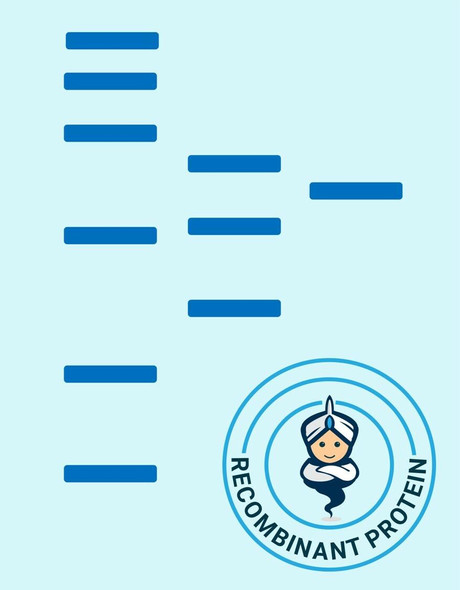Description
| Product Name: | Human CIDEC Recombinant Protein |
| Product Code: | RPPB3186 |
| Size: | 10µg |
| Species: | Human |
| Target: | CIDEC |
| Synonyms: | Cell Death-Inducing DFFA-Like Effector C, FSP27, CIDE3, FPLD5, Cell Death-Inducing DFFA-Like Effector Protein C, Fat-Specific Protein FSP27 Homolog, Cell Death Activator CIDE-3, Fat Specific Protein 27, CIDE-3, CIDEC. |
| Source: | Escherichia Coli |
| Physical Appearance: | Filtered colorless solution. |
| Formulation: | CIDEC filtered (0.4�m) solution at a concentration of 0.4mg/ml in 30mM acetate buffer and 10mM dithiothreitol, pH 4. |
| Stability: | Store at 4°C if entire vial will be used within 2-4 weeks. Store, frozen at -20°C for longer periods of time. For long term storage it is recommended to add a carrier protein (0.1% HSA or BSA).Avoid multiple freeze-thaw cycles. |
| Purity: | Greater than 95.0% as determined by SDS-PAGE. |
| Amino Acid Sequence: | MKHHHHHHASEYAMKSLSLL YPKSLSRHVS VRTSVVTQQL LSEPSPKAPR ARPCRVSTAD RSVRKGIMAY SLEDLLLKVR DTLMLADKPF FLVLEEDGTT VETEEYFQAL AGDTVFMVLQ KGQKWQPPSE QGTRHPLSLS HKPAKKIDVA RVTFDLYKLN PQDFIGCLNV KATFYDTYSL SYDLHCCGAK RIMKEAFRWA LFSMQATGHV LLGTSCYLQQ LLDATEEGQP PKGKASSLIP TCLKILQ |
Cell Death-Inducing DFFA-Like Effector C (CIDEC) belongs to the cell death-inducing DNA fragmentation factor-like effector family, whose members have significant roles in apoptosis. CIDEC is expressed mainly in adipocytes, intestine, heart, stomach, and weakly in the brain, kidney and liver. CIDEC overexpression in preadipocytes induces apoptosis. CIDEC regulates enlargement of lipid droplets.�
CIDEC Human Recombinant produced in E.Coli is a single, non-glycosylated, polypeptide chain (Glu2-Gln238) containing 247 amino acids including a 10 aa His tag at N-terminus. The total calculated molecular mass is 28kDa.
| UniProt Protein Function: | CIDEC: May act as a CEBPB coactivator in white adipose tissue to control the expression of a subset of CEBPB downstream target genes, including SOCS1, SOCS3, TGFB1, TGFBR1, ID2 and XDH. Binds to lipid droplets and regulates their enlargement, thereby restricting lipolysis and favoring storage. At focal contact sites between lipid droplets, promotes directional net neutral lipid transfer from the smaller to larger lipid droplets. The transfer direction may be driven by the internal pressure difference between the contacting lipid droplet pair. When overexpressed in preadipocytes, induces apoptosis or increases cell susceptibility to apoptosis induced by serum deprivation or TGFB treatment. As mature adipocytes, that express high CIDEC levels, are quite resistant to apoptotic stimuli, the physiological significance of its role in apoptosis is unclear. In omental adipose tissue of obese patients matched for BMI, expression levels tend to correlate with insulin sensitivity. Expression is increased 2-3 fold in the group of patients with high insulin sensitivity, compared to the insulin- resistant group. This observation is consistent with the idea that triglyceride storage in adipocytes plays an important role in sequestering triglycerides and fatty acids away from the circulation and peripheral tissues, thus enhancing insulin sensitivity in liver and muscle. This effect is not significant in subcutaneous adipose tissue (PubMed:18509062). In subcutaneous adipose tissue of diabetic patients, tends to negatively correlate with body mass index and total fat mass, independently of insulin sensitivity (PubMed:18334488). 3 isoforms of the human protein are produced by alternative splicing. |
| UniProt Protein Details: | Protein type:Apoptosis Chromosomal Location of Human Ortholog: 3p25.3 Cellular Component: endoplasmic reticulum; lipid particle; cytosol; nucleus Biological Process: regulation of apoptosis; regulation of transcription, DNA-dependent; transcription, DNA-dependent; apoptosis Disease: Lipodystrophy, Familial Partial, Type 5 |
| NCBI Summary: | This gene encodes a member of the cell death-inducing DNA fragmentation factor-like effector family. Members of this family play important roles in apoptosis. The encoded protein promotes lipid droplet formation in adipocytes and may mediate adipocyte apoptosis. This gene is regulated by insulin and its expression is positively correlated with insulin sensitivity. Mutations in this gene may contribute to insulin resistant diabetes. A pseudogene of this gene is located on the short arm of chromosome 3. Alternatively spliced transcript variants that encode different isoforms have been observed for this gene. [provided by RefSeq, Dec 2010] |
| UniProt Code: | Q96AQ7 |
| NCBI GenInfo Identifier: | 20138281 |
| NCBI Gene ID: | 63924 |
| NCBI Accession: | Q96AQ7.1 |
| UniProt Secondary Accession: | Q96AQ7,Q67DW9, Q9GZY9, C9JMN7, |
| UniProt Related Accession: | Q96AQ7 |
| Molecular Weight: | 238 |
| NCBI Full Name: | Cell death activator CIDE-3 |
| NCBI Synonym Full Names: | cell death-inducing DFFA-like effector c |
| NCBI Official Symbol: | CIDEC�� |
| NCBI Official Synonym Symbols: | CIDE3; FPLD5; FSP27; CIDE-3�� |
| NCBI Protein Information: | cell death activator CIDE-3; fat specific protein 27 |
| UniProt Protein Name: | Cell death activator CIDE-3 |
| UniProt Synonym Protein Names: | Cell death-inducing DFFA-like effector protein C; Fat-specific protein FSP27 homolog |
| Protein Family: | Cell death activator |
| UniProt Gene Name: | CIDEC�� |
| UniProt Entry Name: | CIDEC_HUMAN |






